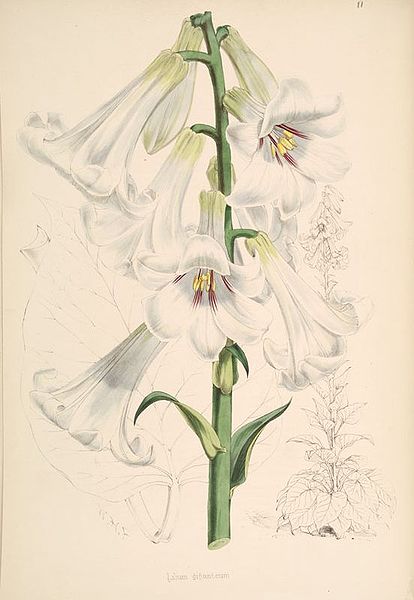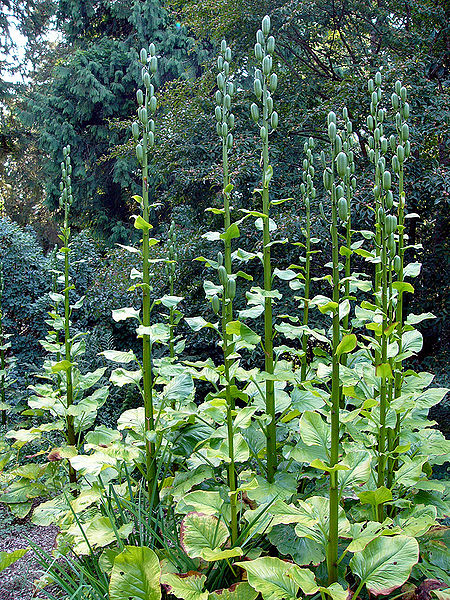 |
|
http://commons.wikimedia.org/wiki/File:Cardiocrinum_giganteum.jpg |
 |
| http://commons.wikimedia.org/wiki/User:Philippe_Giabbanelli |
Translate this page:
Summary
Physical Characteristics

 Cardiocrinum giganteum is a BULB growing to 1.8 m (6ft) by 0.3 m (1ft in).
Cardiocrinum giganteum is a BULB growing to 1.8 m (6ft) by 0.3 m (1ft in).
See above for USDA hardiness. It is hardy to UK zone 7. It is in flower in August, and the seeds ripen in September. The species is hermaphrodite (has both male and female organs) and is pollinated by Insects.
Suitable for: light (sandy), medium (loamy) and heavy (clay) soils and prefers well-drained soil. Suitable pH: mildly acid, neutral and basic (mildly alkaline) soils. It can grow in semi-shade (light woodland). It prefers moist soil.
UK Hardiness Map
US Hardiness Map
Synonyms
Lilium giganteum.
Plant Habitats
Woodland Garden Dappled Shade; Shady Edge;
Edible Uses
References More on Edible Uses
Medicinal Uses
Plants For A Future can not take any responsibility for any adverse effects from the use of plants. Always seek advice from a professional before using a plant medicinally.
Poultice
The leaves are used as an external cooling application to alleviate the pains of wounds and bruises[240]. A paste of the root is applied as a poultice to treat dislocated bones[272].
References More on Medicinal Uses
The Bookshop: Edible Plant Books
Our Latest books on Perennial Plants For Food Forests and Permaculture Gardens in paperback or digital formats.

Edible Tropical Plants
Food Forest Plants for Hotter Conditions: 250+ Plants For Tropical Food Forests & Permaculture Gardens.
More

Edible Temperate Plants
Plants for Your Food Forest: 500 Plants for Temperate Food Forests & Permaculture Gardens.
More

More Books
PFAF have eight books available in paperback and digital formats. Browse the shop for more information.
Shop Now
Other Uses
References More on Other Uses
Cultivation details
Prefers a moist well-drained position in shade and a soil that is rich in leafmould[47, 200]. Requires a deep, very fertile humus-laden soil[233]. Prefers growing in woodland conditions[42, 200]. A monocarpic plant, the bulb takes about 7 years to reach flowering size but then dies after flowering. However, it produces a number of new bulblets at the base and can be propagated by these[47, 200]. These bulblets take 3 - 5 years to flower[200]. The flowers scent the surrounding area with their rich sweet perfume[245]. When planting, only just cover the bulb with leafmould[47]. The bulb is very attractive to slugs, mice and voles and may require protection[200]. Plants seem to be immune to the predations of rabbits[233].
References Carbon Farming Information and Carbon Sequestration Information
Temperature Converter
Type a value in the Celsius field to convert the value to Fahrenheit:
Fahrenheit:
The PFAF Bookshop
Plants For A Future have a number of books available in paperback and digital form. Book titles include Edible Plants, Edible Perennials, Edible Trees,Edible Shrubs, Woodland Gardening, and Temperate Food Forest Plants. Our new book is Food Forest Plants For Hotter Conditions (Tropical and Sub-Tropical).
Shop Now
Plant Propagation
Seed - best sown as soon as it is ripe in a cold frame in the autumn. The plant has delayed epigeal germination and will often germinate in the spring but can take up to 2 years especially if the seed is stored prior to being sown[134]. An alternative is to mix the seed with some moist leafmould and seal it in a plastic bag. Keep this at a temperature of 20°c for 3 weeks then pot up any seed that germinates and place the rest in a fridge for 4 - 5 weeks at 3 - 5°c before sowing in a warm place[138]. Seedlings should be grown on in pots in a shaded position in a cold frame or greenhouse for 3 - 4 years before planting them out in their permanent positions[138]. Bulblets are obtained from the base of the old plant after flowering. Pot up and plant out when well established.
Other Names
If available other names are mentioned here
Native Range
TEMPERATE ASIA: China (Gansu Sheng, Guangdong Sheng, Guangxi Zhuangzu Zizhiqu, Guizhou Sheng, Henan Sheng, Hubei Sheng, Hunan Sheng, Shaanxi Sheng, Sichuan Sheng, Xizang Zizhiqu (south), Yunnan Sheng) TROPICAL ASIA: Bhutan, India (Assam (Khasia Hills), Manipur, Sikkim, Uttar Pradesh (north)), Nepal, Myanmar (northwest)
Weed Potential
Right plant wrong place. We are currently updating this section.
Please note that a plant may be invasive in one area but may not in your area so it's worth checking.
Conservation Status
IUCN Red List of Threatened Plants Status :

Growth: S = slow M = medium F = fast. Soil: L = light (sandy) M = medium H = heavy (clay). pH: A = acid N = neutral B = basic (alkaline). Shade: F = full shade S = semi-shade N = no shade. Moisture: D = dry M = Moist We = wet Wa = water.
Now available:
Food Forest Plants for Mediterranean Conditions
350+ Perennial Plants For Mediterranean and Drier Food Forests and Permaculture Gardens.
[Paperback and eBook]
This is the third in Plants For A Future's series of plant guides for food forests tailored to
specific climate zones. Following volumes on temperate and tropical ecosystems, this book focuses
on species suited to Mediterranean conditions—regions with hot, dry summers and cool, wet winters,
often facing the added challenge of climate change.
Read More
Expert comment
Author
(Wall.)Makino.
Botanical References
200266
Links / References
For a list of references used on this page please go here
Readers comment